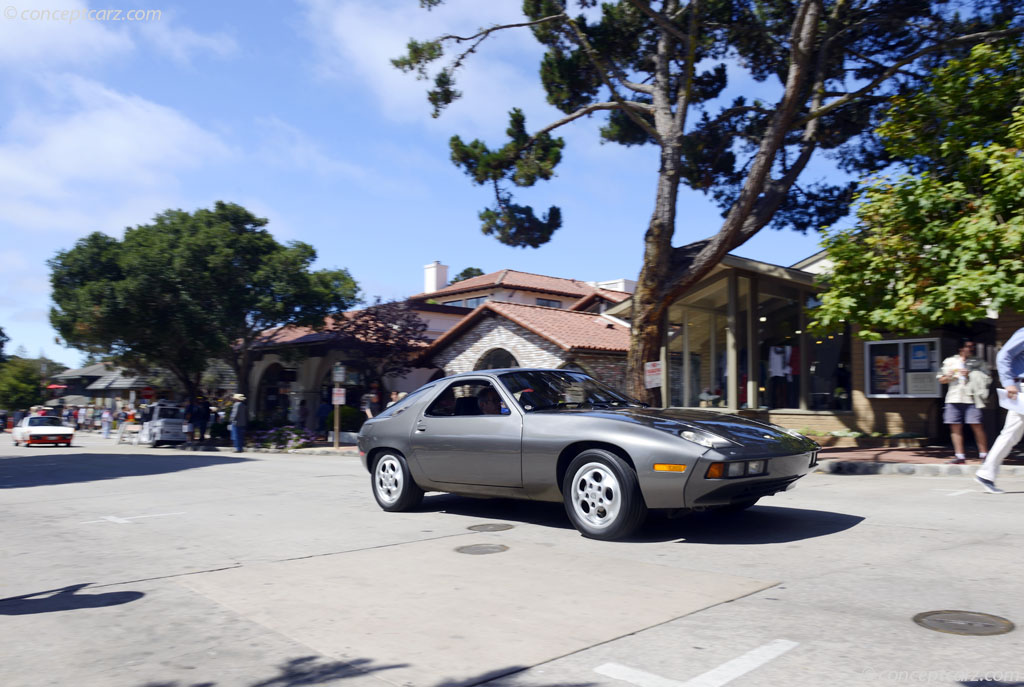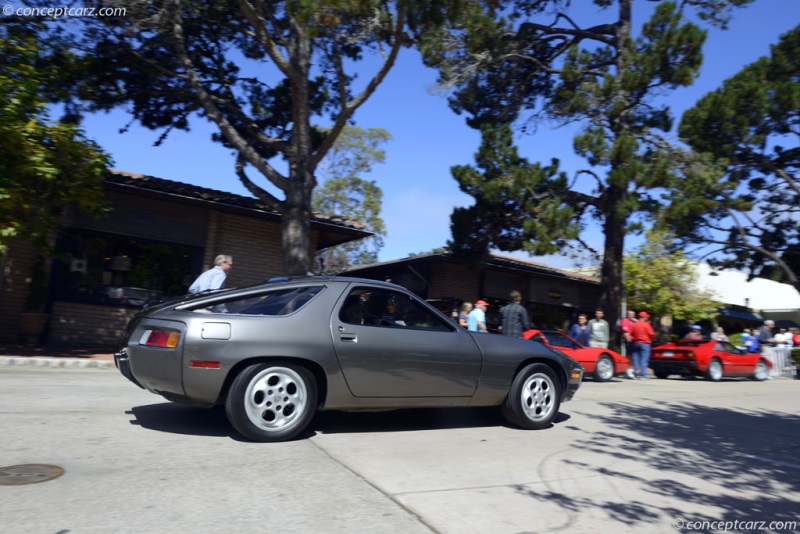The automotive marketplace changed rapidly following World War II, and although the Porsche 356 and 911 had been very successful, the small, rear-engine, air-cooled sports car's popularity began to wane prompting management to explore their options. The new model unveiled in 1977 at the Geneva Internation Motor Show was in stark contrast to its stablemates, and although the 1970s energy crisis sent global petrol prices to record highs, Porsche placed a V-8 engine at the heart of the 928. It was the company's first production V8-powered model.The earliest iterations of this lavish grand tourer were motivated by a 4.5-liter engine rated at 237 horsepower for European-delivery examples. It was quick, stylish, and comfortable, making it a proper long-distance grand-touring car thanks to its 50/50 weight distribution, a clever Weissach rear axle, and responsive steering. The Weissach Axle was a rear-wheel steering system that provided passive rear-wheel steering that aided in stability while braking during a turn. Production began in 1978 and continued through 1995. During its inaugural year, it won the 'European Car of the Year' award and remains the only sports car to have won this competition. Traditionally, this award is bestowed upon sedans (saloons) and hatchbacks. Modifications and evolution of the 928 during its 18-year production lifespan were minimal. Before the arrival of the 928, the 911 had been the company's most recent flagship model. While owner Ferdinand Porsche was considering adding a fuel-efficient, luxury touring car to its lineup, managing director Ernst Fuhrmann persuaded him to explore a grand touring model with a conventional engine configuration. He suggested endowing it with sports car performance and a luxurious, yet spartan interior. DevelopmentThe Porsche 928 would be the company's 'first clean sheet' design, as the 911 was an evolution of the 356, itself owing much to the Volkswagen Beetle. The 914 had been a joint effort by Volkswagen and Porsche, and the 924 was birthed from an abandoned project by Audi and Volkswagen. The early 1970s introduced new safety and emission regulations, particularly in the United States where engine output had grown to dangerous levels and may have continued to grow. The cramped rear engine bay of the 911 made it difficult for future growth and development, especially with emission devices and noise control devices in place. The traditional front-engine layout resolved many of these issues and allowed Porsche to consider engines with larger displacements and many more cylinders. While much of the mechanical configuration was a deviation from the company's traditional practices, the resulting body design had a family resemblance with a gracefully sloping windscreen and rear decklid, and creased and curves as though it were a stretched 911. The development process was one of trial-and-error, with prototype examples being fitted with a 5.0-liter V8 offering upwards of 300 horsepower. Ferdinand Piëch suggested a V10 derivative of the Audi 5-cylinder engine also used to power the Lamborghini Gallardo (and based upon the Volkswagen EA827 engine), but it was ultimately declined. The unit selected was an all-alloy M28 V8 designed to accommodate a low hood line and have the potential for racing. Its 122 mm bore spacing allowed for all-aluminum cylinder barrels devoid of steel liners, along with large water jackets, four-bolt bearings, cast aluminum oil pan, and spark plugs positioned at the top of the head. The unsleeved, silicon alloy engine block was made of lightweight aluminum which resulted in a highly durable cylinder bore.
Both the water and oil pumps were driven by a timing belt and the first two M28 V8 engines received a four-barrel carburetor. Production examples received Bosch K-Jetronic fuel injection, a 4.5-liter displacement, SOHC per bank, and 16-valves. While smaller displacement sizes were considered, as low as 3.3 liters, the 4.5-liter unit provided a balance of performance (240 hp - 220 hp in North America) and fuel economy. ProductionIntroduced in 1977 at the Geneva Motor Show and going on sale later that year as a 1978 model, sales were initially sluggish. Perhaps due to its front-engined configuration which may have upset many Porsche purists or perhaps it was due to the base price was exceeded that of the previous range-topping 911 model. Despite its lower-than-anticipated production figures, the Porsche 928 would remain in production for nearly two decades and would gain a legion of loyal enthusiasts along the way. A total of 17,669 examples were built between 1978 and 1982 along with 8,315 examples of the 928 S (1980-83). Total production through 1995 was 61,056 units. Mechanical SpecificationThe Porsche 928 received a 98.4-inch wheelbase, an overall length of 178 inches, a height of 50.2 inches (initially, later growing to 50.5 inches), and a width of 72.3 inches (later at 74.4 inches). In comparison, the 911 was around 10 inches shorter in length and wheelbase, had a similar height, and was around 12 inches shorter in width. Its flat-six, 3.0-liter engine (at the time of the introduction in U.S. specification) produced approximately 172 horsepower, approximately 50 horsepower less than its front-engine sibling. The Porsche 928 was heavier than the 911 but due to its more neutral weight balance (50/50) and higher engine output, both models had similar performance.The 4.5-liter single overhead camshaft engine powering the 928 was upgraded in 1980 from mechanical to electronic fuel injection for U.S.-destined models. Horsepower output was not affected by this change. By fitting a transaxle, the 928 was able to achieve a 50/50 front/rear weight distribution. A five-speed dog leg manual transmission was standard while the Mercedes-Benz-derived automatic was optional. The automatic initially had three speeds, with the North American market gaining an additional gear in 1983 followed by other markets a year later. Most of the cars built in 1978 and 1979 received the five-speed unit, but as the years progressed, the automatic gained ground, and by the time production ceased, the automatic was more popular. Body StylingThe styling of the Porsche 928 was penned by Wolfgang Möbius under the guidance of Anatole Lapine. Beneath the rear hatchback lid was a large luggage area befitting a Grand Touring automobile. At the front, integrated into the front wings, were pop-up headlamps based on units installed on the Lamborghini Miura. The bumpers were made of polyurethane elastic covered in body-colored plastic and installed into the nose and tail. More than just protection, the bumpers helped reduce drag and were designed as a styling element. 15- or 16-inch 'phone-dial'-style wheels were initially used for the first two years. During the 1980s, most of the 928s rested on 16-inch slotted 'flat disc' wheels. The GTS models had 9-inch wide wheels which necessitated wider rear fenders Mounted at all four corners were two variations of the 17-inch 'CUP' wheels. The CS, SE and 1989 GTs had 16-inch 'Club Sport' wheels, while later examples of the GT used 6-inch 'Design 90' style wheels (optional on S4s during this period). Front and rear spoilers were added on 'S' models from 1980 through 1986 (on North American models beginning in 1983), with the rear spoiler being integrated into the hatch. From 1987 through 1995, side skirts were added, the rear spoiler was a separated wing, and the front spoiler was integrated into the nose.
CoupeThe rear tail-light setup was changed in 1987. InteriorThe Porsche 928 was designed with 2+2 seating configuration, with very minimal (small) seats in the rear. Space was limited for rear occupants due to the transmission hump and little leg room. The front seats were comfortable, divided by a center console that housed the gear shifter and window control buttons. In front of the driver was an instrument cluster that moved along with the adjustable steering wheel (a first for a production automobile). For the 1989 model year, a digital trip computer was added to the dashboard. Porsche 928 S and 928 S2
CoupePorsche introduced the 928 S to the European market in 1980 and during the summer of 1982 (as a 1983 model year) to the North American market. Distinguishable features included wider wheels and tires and new front and rear spoilers. Beneath the bonnet was an enlarged 4.7-liter engine initially offering 296 horsepower (European versions) before further upgrades brought output to 306 hp in 1984. Upgrades included a Bosch LH-Jetronic fuel injection system, Bosch ignition, and high lift camshafts. The S Model was called the S2 in the United Kingdom from 1984 to 1986. The Porsche 928 S produced for the North American market in 1983 and 1984 had smaller valves, smaller diameter intake manifolds, and less aggressive camshafts. Along with emissions and pollution equipment, output was rated at 234 hp. Engines built for the Australian market received a lower compression of 9.3:1 (as opposed to 10.4:1) due to lower-grade fuel (1985 model year).
Coupe
Chassis #: 92A0821081
View info and history
Auction entries : 1A total of 8,315 examples of the 928 S were built from 1980 to 1983, and 14,347 from 1984 to 1986 (928 S and 928 S2).Porsche 928 S Competition GroupDue to emission-robbing equipment, the engine installed in the North American cars produced around 60 fewer horsepower than its European counterparts. Porsche attempted to 'soften the blow' with a 'Competition Group' option with special paint and interior colors, 16-inch flat disc wheels, front and rear spoilers, sport seats, sport springs and Bilstein Shock Absorbers. This option was offered 'officially' in 1981 and 1982 and ended in 1983 when the S model became available. 
Coupe
Chassis #: 92A0821081
View info and history
Auction entries : 1The 928 S was updated for the North American market for 1985, with a new 5.0-liter dual overhead camshaft (DOHC) engine replacing the previous 4.7-liter unit. It had four valves per cylinder and offered a respectable 288 horsepower. To further distinguish them from their predecessors, the interior received new style of seats. The European market continued to use the 4.7-liter engine but compression was lowered to 9.3:1 compression. Catalytic converters became an option in some European countries and Australia for 1986.The 928 S received larger brakes with four-piston calipers, modifications to the suspension, and a modified exhaust system in 1986. These updates began with chassis number 1001, which meant the first thousand examples had the previous year's equipment. Porsche 928 Weissach EditionPorsche sold 202 examples of its 'Weissach Edition' for the 928 to the North American market in 1982. They wore champagne gold metallic paint with matching brushed gold flat disc wheels and a two-tone leather interior. On the dashboard was a plaque containing the production number. Each Weissach Edition came with a three-piece Porsche luggage set. The Weissach Edition could be paired with the Competition Group option which added the S spoilers.Porsche offered the Weissach Edition with the 911 for the 1980 model year and in 1981 for the 924.Porsche 928 S 50th Jubilee (a.k.a. 'Ferry Porshe Edition')In celebration of the company's 50th year of existence as an automobile manufacturer, Porsche built 141 examples of its '50th Jubilee' 928 S (not available in the U.S. or Canada). Ferry Porsche's signature was embroidered into the front seats, leading to the model commonly referred to as the 'Ferry Porsche Edition.' Riding on flat disc wheels, the exterior was painted in meteor metallic paint with wine red leather interior and special striped fabric seat centers.Porsche 928 S4In mid-1986, Porsche offered the 928 S4 variant as a 1987 model year. A 5.0-liter V8 engine was used for all markets and offered 316 horsepower. It was paired with a new single-disc clutch in manual transmission cars, and the automatic examples received a larger torque converter. The styling differences that previously existed between models sent to different markets were gone, with the only differences being miles or kilometers, the availability of catalytic converters, and front and rear bumper shocks. The Australian market continued to receive a lower compression setting due to low-grade fuels. The manual transmission was not offered in 1990 or 1991. Production of the 928 S4 lasted from 1987 to 1991 with 15,682 examples built.Factory Drivers
The Porsche factory made five white lightweight S4 models with manual transmissions for its factory drivers at the time of Derek Bell, Jochen Mass, Hans Stuck, Bob Wollek and Jacky Ickx. These were similar to the 928 Club Sport models.Porsche 928 Club Sport (CS)The Club Sport was offered to continental Europe and the U.S. in 1988 and was a tamer version of the 1987 factory lightweight prototype. The Club Sport was 220 lb (100 kg) lighter than the 928 S4.The Porsche 928 Club Sport was produced in 1988 and some of 1989 with a total of 19 examples built. Porsche 928 SEThe Porsche 928 SE was built in 1988 and 42 examples were constructed. Sometimes referred to as an S4 Sport (due to the model designation on the rear bumper), they were given modifications such as upgraded (GT) pistons, cams and engine ECU programs. Only the manual transmission was offered and a few examples had a stronger, short-ratio manual unit. Porsche 928 GTThe Porsche 928 GT arrived near the close of 1988 and served as a replacement for the Club Sport and SE. Produced through 1991, a total of 2,078 examples were built. Equipment included a ZF 40% limited-slip differential (like the Club Sport and SE) and was offered solely with a manual transmission. Porsche 928 GTS
The final Porsche 928 variant was the GTS of late 1991 as a 1992 model in Europe and in the spring of 1992 as an early 1993 model in North America. A larger 5.4-liter engine offered 345 horsepower and required larger front brakes to cope with the increase in power. Changes were made to the bodywork.Only seventy-seven examples of the GTS were sent to the United States. A fully loaded example could exceed $100,000 in 1995, making them the most expensive car on the market. Produced from 1992 to 1995, a total of 2,904 examples of the GTS were built.Total Porsche 928 production - from 1978 to 1995 - totaled 61,056 units.
by Daniel Vaughan | Jan 2023
Both the water and oil pumps were driven by a timing belt and the first two M28 V8 engines received a four-barrel carburetor. Production examples received Bosch K-Jetronic fuel injection, a 4.5-liter displacement, SOHC per bank, and 16-valves. While smaller displacement sizes were considered, as low as 3.3 liters, the 4.5-liter unit provided a balance of performance (240 hp - 220 hp in North America) and fuel economy. ProductionIntroduced in 1977 at the Geneva Motor Show and going on sale later that year as a 1978 model, sales were initially sluggish. Perhaps due to its front-engined configuration which may have upset many Porsche purists or perhaps it was due to the base price was exceeded that of the previous range-topping 911 model. Despite its lower-than-anticipated production figures, the Porsche 928 would remain in production for nearly two decades and would gain a legion of loyal enthusiasts along the way. A total of 17,669 examples were built between 1978 and 1982 along with 8,315 examples of the 928 S (1980-83). Total production through 1995 was 61,056 units. Mechanical SpecificationThe Porsche 928 received a 98.4-inch wheelbase, an overall length of 178 inches, a height of 50.2 inches (initially, later growing to 50.5 inches), and a width of 72.3 inches (later at 74.4 inches). In comparison, the 911 was around 10 inches shorter in length and wheelbase, had a similar height, and was around 12 inches shorter in width. Its flat-six, 3.0-liter engine (at the time of the introduction in U.S. specification) produced approximately 172 horsepower, approximately 50 horsepower less than its front-engine sibling. The Porsche 928 was heavier than the 911 but due to its more neutral weight balance (50/50) and higher engine output, both models had similar performance.The 4.5-liter single overhead camshaft engine powering the 928 was upgraded in 1980 from mechanical to electronic fuel injection for U.S.-destined models. Horsepower output was not affected by this change. By fitting a transaxle, the 928 was able to achieve a 50/50 front/rear weight distribution. A five-speed dog leg manual transmission was standard while the Mercedes-Benz-derived automatic was optional. The automatic initially had three speeds, with the North American market gaining an additional gear in 1983 followed by other markets a year later. Most of the cars built in 1978 and 1979 received the five-speed unit, but as the years progressed, the automatic gained ground, and by the time production ceased, the automatic was more popular. Body StylingThe styling of the Porsche 928 was penned by Wolfgang Möbius under the guidance of Anatole Lapine. Beneath the rear hatchback lid was a large luggage area befitting a Grand Touring automobile. At the front, integrated into the front wings, were pop-up headlamps based on units installed on the Lamborghini Miura. The bumpers were made of polyurethane elastic covered in body-colored plastic and installed into the nose and tail. More than just protection, the bumpers helped reduce drag and were designed as a styling element. 15- or 16-inch 'phone-dial'-style wheels were initially used for the first two years. During the 1980s, most of the 928s rested on 16-inch slotted 'flat disc' wheels. The GTS models had 9-inch wide wheels which necessitated wider rear fenders Mounted at all four corners were two variations of the 17-inch 'CUP' wheels. The CS, SE and 1989 GTs had 16-inch 'Club Sport' wheels, while later examples of the GT used 6-inch 'Design 90' style wheels (optional on S4s during this period). Front and rear spoilers were added on 'S' models from 1980 through 1986 (on North American models beginning in 1983), with the rear spoiler being integrated into the hatch. From 1987 through 1995, side skirts were added, the rear spoiler was a separated wing, and the front spoiler was integrated into the nose.
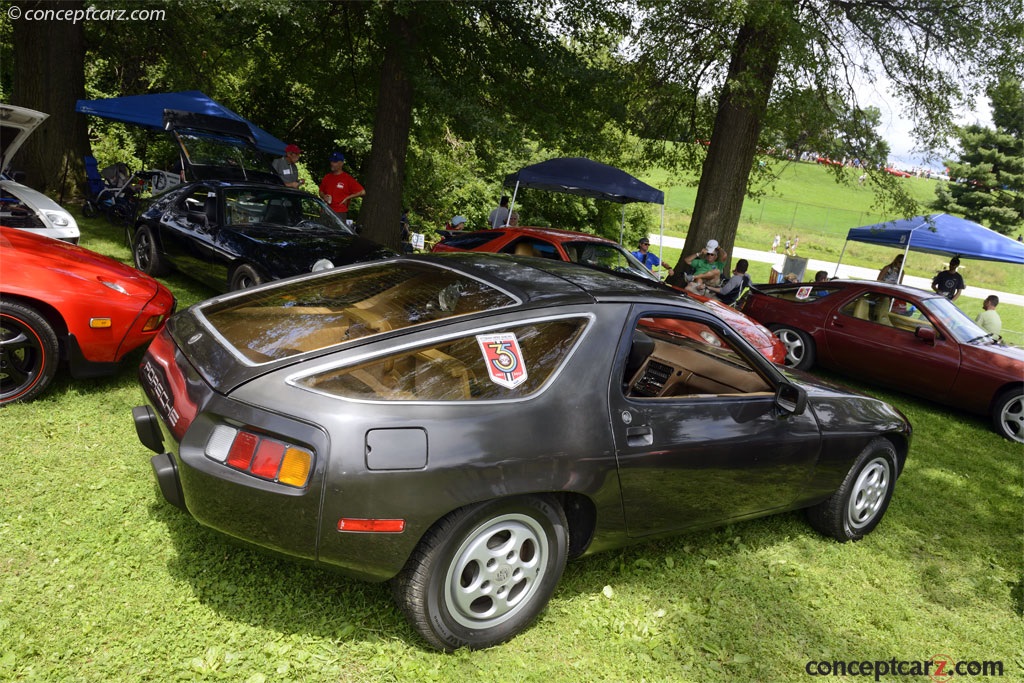
Coupe
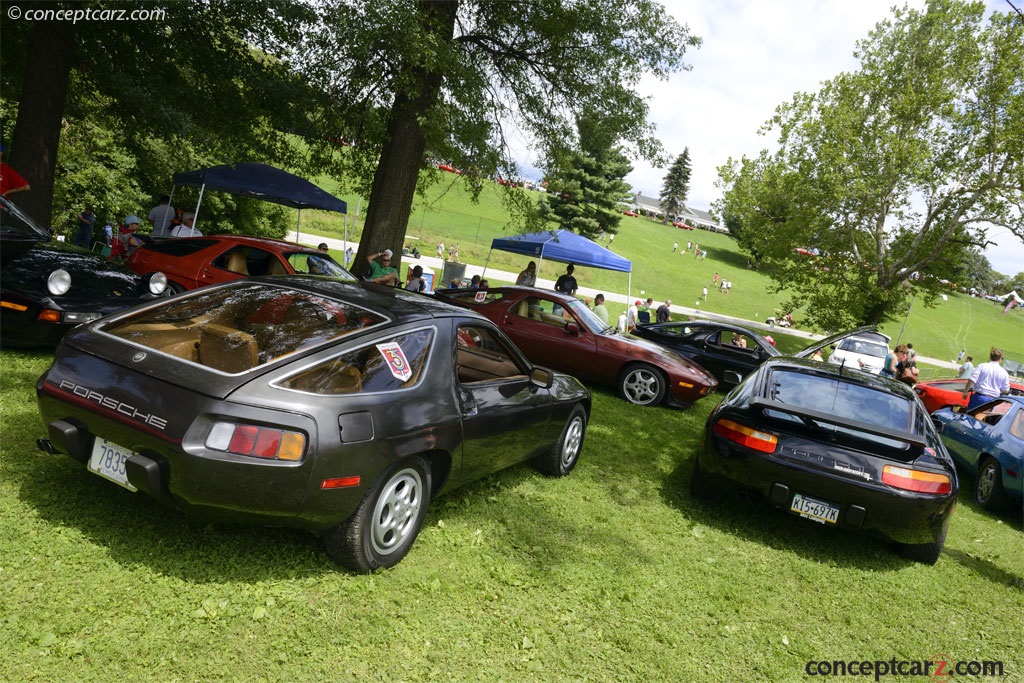
Coupe
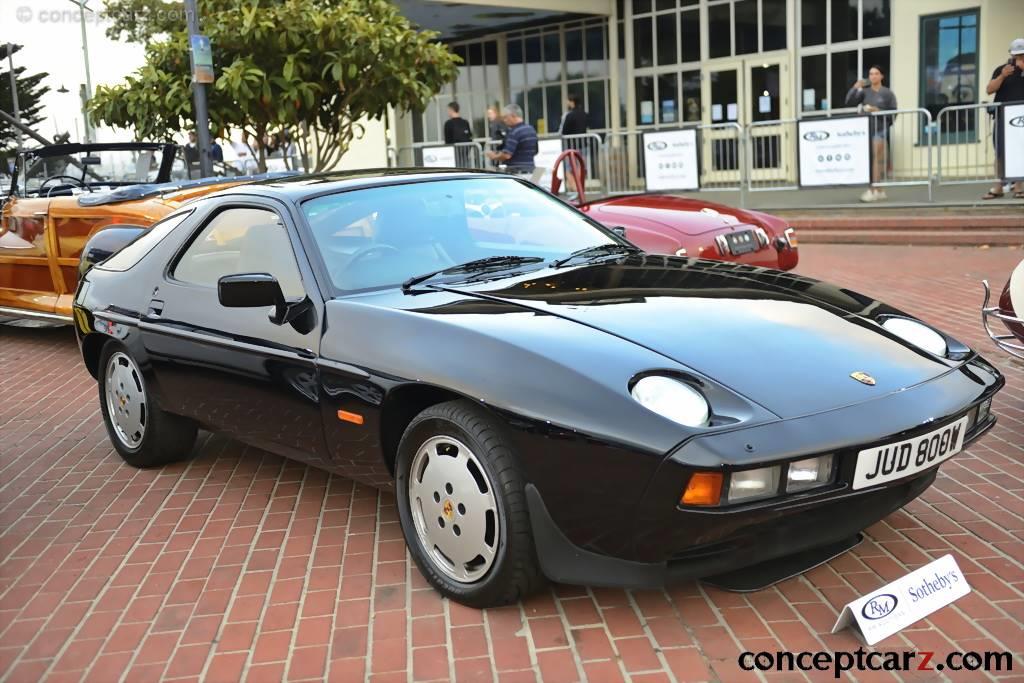
Coupe
Chassis #: 92A0821081
View info and history
Auction entries : 1
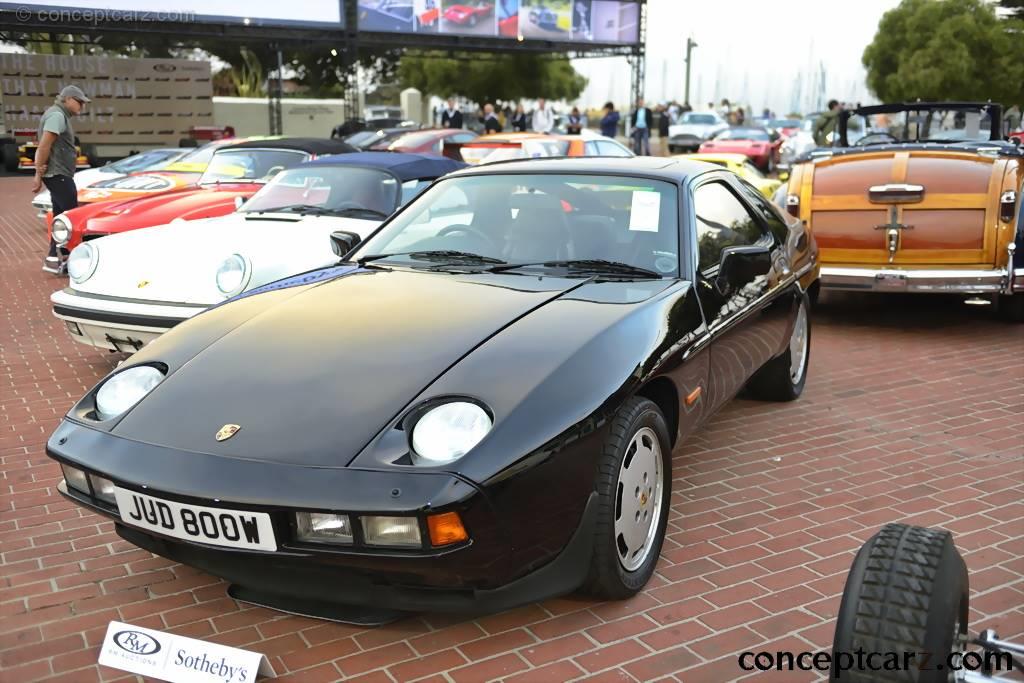
Coupe
Chassis #: 92A0821081
View info and history
Auction entries : 1
The Porsche factory made five white lightweight S4 models with manual transmissions for its factory drivers at the time of Derek Bell, Jochen Mass, Hans Stuck, Bob Wollek and Jacky Ickx. These were similar to the 928 Club Sport models.Porsche 928 Club Sport (CS)The Club Sport was offered to continental Europe and the U.S. in 1988 and was a tamer version of the 1987 factory lightweight prototype. The Club Sport was 220 lb (100 kg) lighter than the 928 S4.The Porsche 928 Club Sport was produced in 1988 and some of 1989 with a total of 19 examples built. Porsche 928 SEThe Porsche 928 SE was built in 1988 and 42 examples were constructed. Sometimes referred to as an S4 Sport (due to the model designation on the rear bumper), they were given modifications such as upgraded (GT) pistons, cams and engine ECU programs. Only the manual transmission was offered and a few examples had a stronger, short-ratio manual unit. Porsche 928 GTThe Porsche 928 GT arrived near the close of 1988 and served as a replacement for the Club Sport and SE. Produced through 1991, a total of 2,078 examples were built. Equipment included a ZF 40% limited-slip differential (like the Club Sport and SE) and was offered solely with a manual transmission. Porsche 928 GTS
The final Porsche 928 variant was the GTS of late 1991 as a 1992 model in Europe and in the spring of 1992 as an early 1993 model in North America. A larger 5.4-liter engine offered 345 horsepower and required larger front brakes to cope with the increase in power. Changes were made to the bodywork.Only seventy-seven examples of the GTS were sent to the United States. A fully loaded example could exceed $100,000 in 1995, making them the most expensive car on the market. Produced from 1992 to 1995, a total of 2,904 examples of the GTS were built.Total Porsche 928 production - from 1978 to 1995 - totaled 61,056 units.
by Daniel Vaughan | Jan 2023
Related Reading : Porsche 928 History
Porsche introduced the 928 at the Geneva Auto Show in 1977 as a potential replacement for the 911. The design and development of the vehicle began in 1971. The 928 was designed as a luxurious car and a grand tourer, but with its excellent weight distribution and V8 engine, it was a performance machine. In 1978 it was awarded the prestigious European Car of the Year. Ernst Fuhrman, Porsches Managing....
Continue Reading >>
Continue Reading >>
Related Reading : Porsche 928 History
Landing on the scene in 1978, the Porsche 928 is a sport-GT car sold by Porsche AG of Germany. From the beginning, the 928 was meant to be the replacement of the legendary 911. At times the 911 had undergone some criticism so Porsche hoped to eliminate that with the brand new car that handled like a sports car but had the luxury features of a sedan. Porsche had produced only six front-engined models,....
Continue Reading >>
Continue Reading >>
Similar Automakers
1980 Porsche 928 Vehicle Profiles
Recent Vehicle Additions
Performance and Specification Comparison
Price Comparison
$17,000 - $21,000
$27,750 - $29,200
928 Specification Comparison by Year
Year
Production
Wheelbase
Engine
Prices
Related Automotive News

2024 Mazda MX-5 Miata: Pricing and packaging
MX-5 Miata receives key updates inside and out that further refine the roadsters successful formula New available Asymmetric limited-slip differential improves MX-5 Miatas renowned progress...

Past Best of Show Winners at The Pebble Beach Concours d'Elegance
overview1
The 70th anniversary of the Pebble Beach Concours dElegance was celebrated with a spectacular display of previous Best of Show winners. Thirty-seven examples graced the showfield and many were still with the same owners who raised the trophy...

MAZDA SELLS OUT INITIAL ALLOCATION OF 1,000 MX-5 MIATA RF LAUNCH EDITIONS
Two-Thirds of Customers Select Manual Transmission, Deliveries to Begin Early 2017
IRVINE, Calif. (October 11, 2016) – Mazda North American Operations (MNAO) today announced that it has sold out of the 1,000-car allocation for the 2017...

2017 MAZDA MX-5 MIATA RF PRICED FROM AN MSRP1 OF $31,555
IRVINE, Calif. (October 4, 2016) – Coming standard with exotic looks and an unrivaled driving experience, presale orders for the 2017 Mazda MX-5 Miata RFbegan last week with great fanfare for loyal Mazda customers and this week to the general...

PRICING AND SPECIFICATION FOR NEW MERCEDES-BENZ C-CLASS CABRIOLET REVEALED
Prices start at £36,200 OTR for petrol-powered C 200
Aircap, Airscarf and Memory Package come as standard
Choice of two trim lines and diesel and petrol engines – plus high-performance Mercedes-AMG models
Electrically-operated fabric roof offered...
